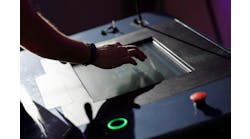Call 734/477-0600, email [email protected] or browse to www.profaceamerica.com/blue.
With Blue 3.0, Pro-face America has modernized the user experience with a human-machine interface (HMI). "Just like the way you interact with your smartphone using gesture controls such as pinch, swipe and zoom, we want to implement that type of experience with HMIs," says George Caudle, offer management at Pro-face America.The Blue 3.0 software will provide a user experience similar to a smartphone when surfing the Web or interacting with apps. "The operation of the HMI will feel like an app as far as navigation, which is much different than what is available in the HMI market today," says Caudle.
[javascriptSnippet ]
[pullquote]Many HMIs on the market are basically single touch. "You touch a button to go to a screen, maybe a popup window provides information, instructions or fault indication," says Caudle. "This new software changes the way operators interact with an HMI to monitor the machine or process. Gesture controls are a big part of it."
With the gesture controls, the navigation between screens is significantly different than the way traditional HMIs operate. "Imagine having a screen with an overview of the plant floor," suggests Caudle. "In that overview, there are three multi-station assembly lines. When an alarm occurs on the second assembly line, for example, instead of hitting a button to go to a screen for details about a line or station, the operator would just zoom in on the second assembly line, and, as he zooms in, the information on the screen changes—additional details appear."
Instead of pushing buttons to navigate and change screens, the operator dynamically zooms in and out. Another part of the zoom functionality includes swiping and scrolling. The graphical information displayed is part of a large canvas that reveals new information as an operator pans down an assembly line.
Blue software supports three levels of zoom. The first level is the overview; the second level focuses on an assembly line; and the third level of zoom could be the actual information at a local control panel. It depends on how programmers set up the graphics, but details increase with the zoom level.
"This large canvas also supports vector graphics so when zooming in and out, the resolution is maintained," says Caudle. "This is an important technology feature in any HMI. In the past, a bitmap or similar file would get grainy and blurred when zooming in. That does not happen with vector graphics—the edges stay sharp."
This modernization of industrial HMIs does require a programmer to change the way an HMI is developed. Traditionally, an HMI has a screen and the boundaries are set by the screen size. With Blue, the developer has a large canvas and smaller window to look through.
"As objects are added to a screen during development, different zoom visibility attributes can be assigned," says Caudle. "For example, when programming an attribute for a data field such as speed, the graphical object can be configured to be visible in different zoom levels, such as levels 2 and 3 but not Level 1."
Pro-face feels like the market is ready for gesture-like controls and navigation, but it does depend on demographics. "The younger operators will expect this type of functionality," says Caudle. "The market has come a long way from the pushbuttons, pilot lights and meters of old and the text displays that soon followed and then turned into the graphical displays that have been around for decades. The way that operators interact with HMIs hasn't changed in 20 years. Although functionality and Windows features have been added, more data is stored and accessible and performance has improved dramatically, the basic user experience hasn't changed. The introduction of Blue 3.0 is trying to change that. It will give industrial HMIs a more modern experience."
In an application, an operator will change a view depending on how much information is needed. The HMI will automatically resize objects. A trend graph is an example of this. Depending on how the HMI is programmed, pinching down to reduce the size of a trend graph can automatically scale the trend, and it can enable other graphics such as a meter or another trend graph to appear.
The graphics are also automatically scalable to various screen sizes and resolutions. HMIs developed for a 7-inch screen can easily be used on a 15-inch screen, smartphone or tablet. With this HTML5 technology, no reprogramming or resizing of graphics is necessary when running on different devices.
"The current Pro-face HMI software is GP-Pro EX and has been available for about 15 years," says Caudle. "However, the Blue software is all new—totally redesigned. It also shouldn't be confused with Blue Open Studio, which is a low-end SCADA package."
ALSO READ: The human factors of panel layout
Just like GP-Pro EX, a couple hundred drivers are available with Blue and it can function as an OPC UA server. Capabilities depend on the type of HMI hardware chosen. As far as connectivity goes, in a high-end HMI or industrial PC, there can be 10 simultaneous drivers running. Even the low-end, 4.3-inch HMIs can support two simultaneous protocols. In addition to the Pro-face HMI hardware, there is a runtime version of the Blue software that can run on a Windows operating system and any PC.







